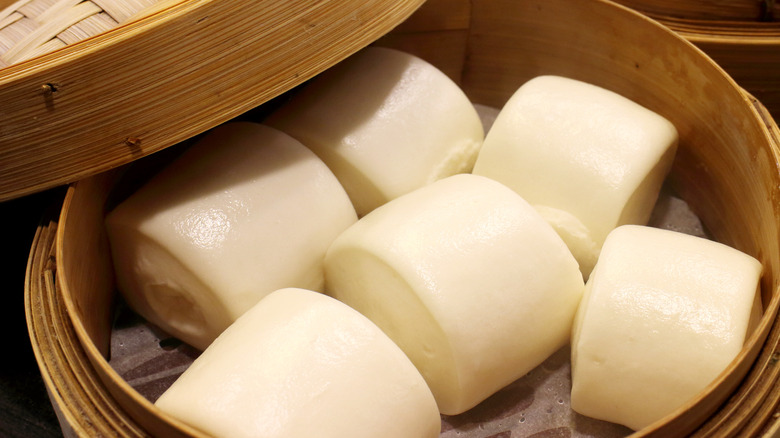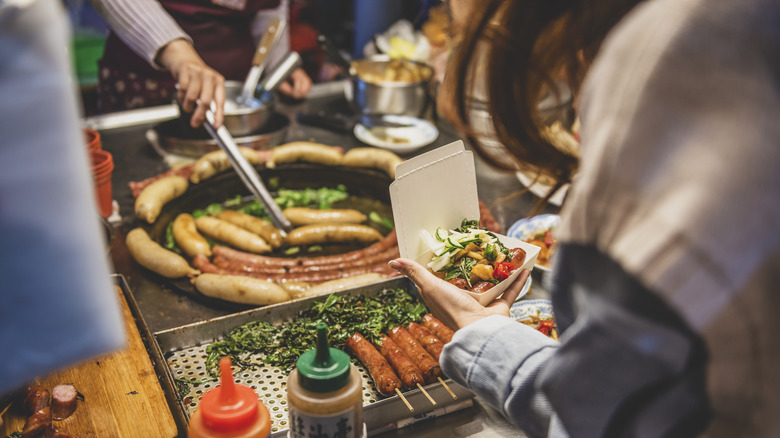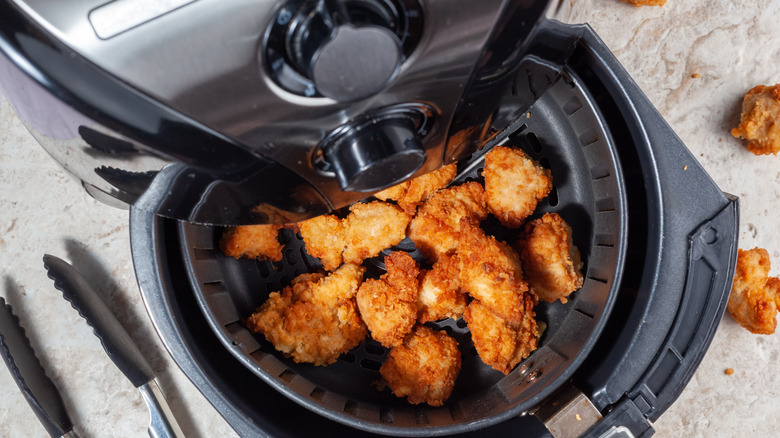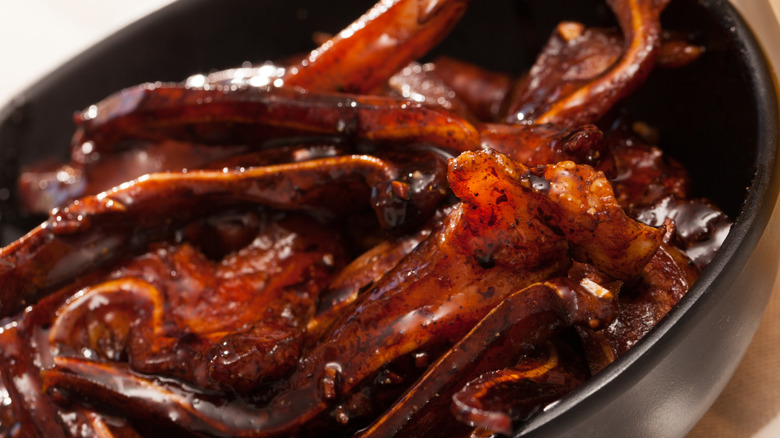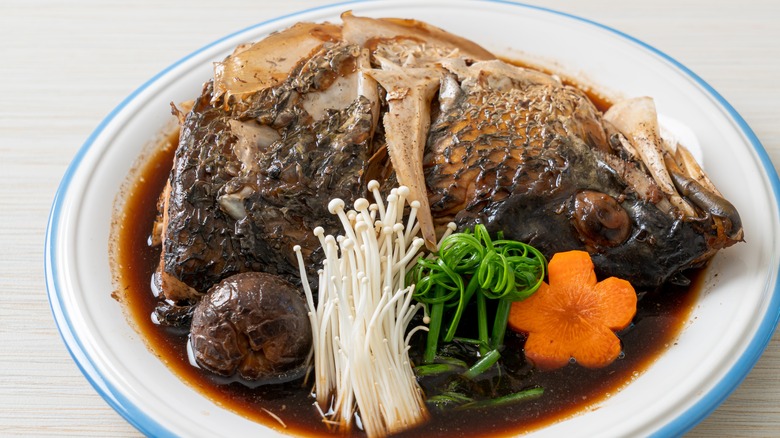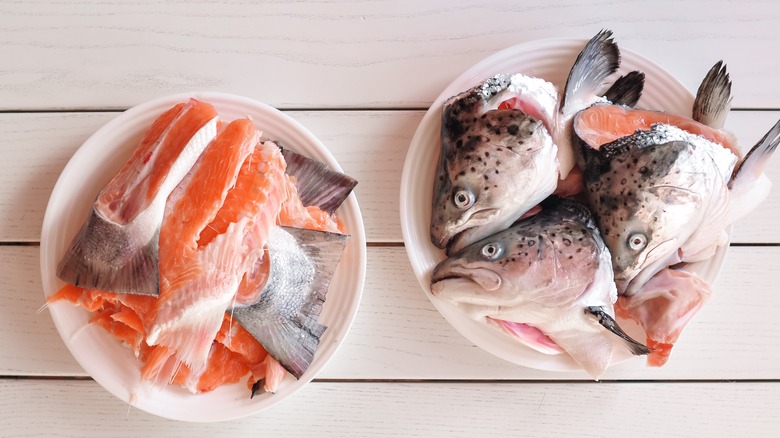Tiffy Chen Talks Quick Eats And Fast Food - Exclusive Interview
It's easy to like Tiffy Chen. Who doesn't fall for someone who teaches you how to make strawberry Santas (Santa Tanghulu) one day, demonstrates tomato and egg noodle soup the next, and takes you to McDonald's in Taiwan on the third? The Taiwanese-born, Vancouver-based blogger and founder of Tiffy Cooks has over 1.1 million followers drinking in her fast but delicious recipe advice — much of it Asian-inspired, but adjusted to fit North American market availabilities. Hang out with Chen, and she'll tutor you in the arts of air-fried Taiwanese street corn, golden prawn pancakes, ginger-glazed oyster mushrooms, and 20-minute creamy miso ramen noodles.
She's not (currently) looking to helm a restaurant. Instead, Chen is a self-described foodie who loves to eat and knows how to cook so well that Penguin Random House is preparing to publish her first cookbook in February of 2024. The book, Chen told Mashed in our exclusive interview, is a love letter to her family — particularly Chen's mother and grandmother, who taught her to make many of the recipes within its pages. She gave us a preview of that as well as some unmissable air-fryer tips and street food pointers.
Tiffy Chen gives us a glimpse into her upcoming cookbook
You have a cookbook coming out in February 2024. There's a lot of your own personal family history and your cookbook. You and your mom test out the recipes that you make for social media. Can you share your favorite memory of cooking with your mother with us?
We are in transcript editing round four, now — very exciting ... The whole purpose of making the cookbook was definitely to memorize all the recipes I had growing up. I came from a family full of foodies, and these are home cooks. My grandma's an amazing home cook. My dad loved trying new dishes. Me and my mom love cooking.
One of my favorite photos [is of] me and my grandma and my mom in our kitchen ... I was young, in kindergarten. A lot of the recipes in my cookbook are my family's recipes or even recipes that I grew up eating, but I changed it throughout ... [to reflect] the way I immigrated to Canada, with ingredients that I [find] here and that make [the recipes] more customizable so people can make [them] at home.
... Food is definitely the love language of my family. The way my grandma shows love to my mom is cooking. The way my mom shows love to me is cooking. Now it's a full story moment where we can share my love language to them by sharing ... cooking for them, but also putting their recipes in a book, officially. It's a dream come true for all of us.
What's the recipe in your cookbook that you are most excited about right now?
It's a very simple dish, but it's called mantou. It's basically a steamed bun recipe ... It's my childhood in a whole dish. I grew up eating this from my grandma. When we moved here, my mom was actually missing my grandma's recipe, so she started recreating it from scratch, and she taught me how to make it. It was a full story moment, and we got to test out the recipe again when I went back to Taiwan a month ago with my grandma.
[We were] making it from scratch together and she approved of the recipe. It's a full story moment of something that my grandma made for my mom and my mom made for me, and now we're putting it into an actual cookbook together.
Tiffy Chen's go-to Taiwanese McDonald's order
You mentioned your recent trip to Taiwan. At McDonald's in Taiwan, you're a big fan of its corn soup. Can you give us your go-to McDonald's order in Taiwan?
For sure. I always get the fried chicken, and surprisingly enough, the fried chicken in McDonald's [in] Taiwan is one of the best I've ever had. It's really crispy [and] juicy on the inside. I always get the corn soup. I'll then get fries and I'll rip them up, half of them, and I'll put them in the soup and soak them so it becomes like a ... creamy corn soup. That's always my go-to order whenever I go to Taiwan: the corn soup, small fries ripped up in the soup, and a fried chicken, like a drumstick.
Why do you think the fried chicken is better in Taiwan?
It's crispy, but it's not oily and it has a very light batter. It's inspired by Western fried chicken and Taiwanese fried chicken. We have light batters in Taiwan, so it has a very light crispy batter. It's not too thick, but it's still super crispy, but the inside is marinated so it's still very juicy. That's why you can have tons of it and you don't even realize you're eating so much fried chicken, because it's not heavy.
While we're on the subject of fast food, you professed a love for Costco's hot dogs and chicken strips. What's your number one Costco food court hack or tradition?
I'm not as fun when it comes to Costco foods, but I love their hot dogs. I love their hot dogs, and I do love their chicken strips, but if you're in Canada, you've got to try their poutine. Canadian Costco poutine is one of the best poutines I've had. The gravy's delicious. The cheese is super melty. Definitely, if anyone's ever in the Canadian side of Costco, [you have] to get the poutine there. It's probably better than any other fast food poutines I've had.
Those are big words.
Fast food only though — not the traditional ones, but fast food. If you want something quick and easy, it's really good.
Tiffy Chen's street foods rule of thumb
As someone who grew up eating street food and continues to share her love for street foods, can you give us your top tip for picking out a good street food vendor? And what's your top warning sign — where should we stay away?
Nowadays, especially with the world of digital media, there are tons of blog posts and Google reviews when it comes to street food, so we're lucky in that sense. But definitely trust your gut. Usually, when something smells good, when it comes to street food, you can smell it from blocks away. That's something that I always depend on, especially when it's Taiwanese street food. If I'm in Taiwan, I can smell a very good vendor from blocks away ... and there's always lines. These street foods are oftentimes local favorites. If you ask around [to] local people about what tastes good, usually, they'll have street food recommendations.
Street food owners ... the reason why I love them a lot is because a lot of times, they specialize in one dish. A lot [of] times, they themselves have a very strong passion for that dish. Even when I order, I'll ask the owner, "What is your number one recommendation? What do you like on the menu?" ... That's the main difference between street food and restaurants — the owner's love toward that one specialized dish that got them started in the first place.
When it comes to street food that [I'll] stay away [from], it depends. A lot of times, it also depends on health and cleanliness and safety. That's hit or miss. It's hard to judge when it comes to that stuff. I grew up eating lots of night market food, lots of street food. You can tell by standing at their stall how much love the owner has toward their food and the pride.
Tiffy Chen's top air frying chicken tip
What is your top street food memory, and where?
My top is definitely in Taiwan. I love night markets. This trip, I went to a very amazing night market in Taiwan where as a group, [all the vendors] agreed that they wouldn't have any repetition. Every stall had something that they specialized in. It was really cool that every stall you go to, there's something cool and they're all working alongside each other.
My favorite is always [a] green crispy green onion pancake, and I'll always add an egg and basil. That's a special dish that you find in Taiwan night market street food. The basil is a must. Usually, people don't add it in, but when you add it in, it adds so much flavor to it and makes it super fresh, too.
You are an air fryer convert, and one of your favorite things to make in the air fryer is chicken wings. Can you give us your tip for a great air fryer chicken wing?
There are a few. The number one tip that people always forget about is adding a little bit of baking powder. Baking powder will help crisp up and dry up the skin, which will make [your chicken] super crispy when you add it into the air fryer. I also add in a little bit of oil, so you [can] toss the chicken in some oil before adding it in, or you can spray a little bit of oil on top before you air fry the chicken.
The last thing is not to overcrowd the air fryer. The more space you leave, the more [the air fryer is] able to easily fry up and crisp up all the edges. But I definitely am a big lover of air fryer chicken wings.
Tiffy Chen's upcoming quick recipes are mouthwatering
You have mastered the art of delicious, healthy, 20-minute recipes. What's your favorite?
I'm in the process of doing that right now, but I'm going to be doing a whole series in January where I'm going to launch another series — a bunch of new 20-minute recipes. I'm currently in the kitchen testing out more, hopefully to bring out more recipes for people, especially during the new year when people want to be cooking more at home.
My favorite recipe of all time — I pin it and always tell people try it; it's my most viral recipe — is my 10-minute spicy garlic noodle recipe. It's something that I have at least once a week. It saves you so much time. There's so much customization to it. You can add in different vegetables [and] different proteins of your choice. A lot of times, [it's] the recipe that you have all ingredients already at home.
In the new year, I hope to make more easy recipes for people to recreate. I have a noodle soup recipe coming up in January that I've finished testing recently. I have a mala tang recipe coming out, which is like a spicy stir-fry recipe. They're all coming up soon, and I'm excited to share more 20-minute recipes.
Tiffy Chen talks ugly foods on social media
You once admitted that you think fried mushrooms are better than fried chicken. While we're on that subject, what is your most controversial food opinion?
I have a series right now called "Ug-licious," and the goal of that is to showcase different foods or recipes that are not seen on mainstream media. That includes pig ears. I've done a recipe on that. Chicken feet, intestines, these different parts ... What I believe about that is that it may seem different and controversial for [some] people, [but in] different parts of the world, a lot of this is what they eat.
On top of that, it's also a way of not wasting food. I'm a very strong believer that [eating these kinds of things] is a good way of making sure that every part of the animal is eaten. A lot of times, [for] these parts of the animal, there are amazing recipes behind there. That's one of my goals — to slowly share these different recipes, these different body parts that are not getting eaten. It really does help with food waste and also educates people on different food cultures that are not shown in the mainstream media.
Can you reflect a little bit on ugly foods that don't get enough attention on social media? Do you think social media is doing a disservice to the diversity of food culture because we're so focused on beauty?
Wow. I definitely think that, not even just with social media — even with mainstream restaurants. There are also delicious restaurants out there, small street vendors, [and] sometimes they make the best food. We've all been to restaurants where it's super social media[-oriented], where [customers] take pictures. But when we're actually eating the food, it's maybe not as delicious as [compared to] how beautiful the photo becomes.
With social media — especially with short-form videos nowadays — we only have a few seconds to capture the audience's attention. [If you're] doing dishes that are not as mainstream, it's hard to make it delicious while still capturing the audience's attention.
I have seen videos where people are using these interesting ingredients, but they're [not] doing the food justice in the sense of making it delicious. They're using it as a shock factor to continue the video ... People can showcase pig ears in a controversial way to gather attention, but not many people are showing it in a way of how we actually eat it in our different cultures.
What's amazing is when I posted the recipe ... it was so interesting in the comments that a lot of other cultures also have this dish, and they have it a different way. That's [what's] amazing about ["Ug-licious"], is getting the conversation started. Even for me, I only know how to cook pork lard in this way because that's how I grew up. It was amazing to see other cultures and how they use the ingredients, and that educates me too on different ways that I can use these ingredients.
The ug-licious foods you should try
Is there an underrated or an ug-licious food that you wish we would be paying more attention to in a respectful way?
A dish that I hope to do down the road ... I'm not just trying to capture the audience's attention by using this ingredient. Intestine is delicious. It's one of my favorite ingredients to use. It's actually used in so many other cultures and so many other dishes. That's probably going to be something that's coming up soon in the "Ug-licious" series, or even fish heads. I'm a big fan of using organs, every part of the animal, and not doing any food waste.
These dishes, these ingredients, you can mostly find them in a lot of local Asian grocery stores. They're really affordable, too. For people who are looking for affordable ways to create different recipes and to try different dishes — or even people who grew up eating [these dishes] but are too ashamed to eat it or too embarrassed to cook it or to order it — hopefully, this can also inspire them to embrace their culture and actually enjoy when it comes to food that they want to eat.
Tiffy Chen's guide to cooking delicious dishes with fish heads
Let's go back to intestines or fish heads, whichever you want to focus on. Can you give us a tip or a method for integrating either into a dish?
I'll do fish head because that's a little bit more common. With fish head, my dad introduced it to me when I was very, very young. There's so many different ways [of] enjoying it. The best part about fish head is ... you don't have to go out of your way to get it, to try it. It's usually part of a fish — it's just that no one's feeding [you] the part of the head.
There's different ways of enjoying it. You can pan-fry it so it becomes super crispy, which is a very popular dish in Asian cuisines. Salmon cheek is a very popular dish in Japanese cuisine, too. Another easy way is to make it into soup. Fish head soup is a very popular way. There's tons of collagen and bone in the soup and the fish. Fish head has a very similar taste to the rest of the fish — it's not too different.
If someone was to try for the first time, I'll definitely say don't be shy and try the eyes. The eyes is usually what people give. In Taiwan, it's their way of showing respect, because there's only two eyes in a fish. When we're sitting at the table, [to serve someone fish eyes means] that everyone's trying to give them good luck. Also, it's funny, but [we have a saying that] the more fish eye you eat, the better it is for your eyes, which is what we believe. It's also good for your health.
Definitely, you can pick at it, but [fish head is] a great way to start because it does come along with the fish. Next time, rather than cutting it off, pan-fry it together with a whole [fish], then give it a try!
Tiffy Chen talks facing social media's ugly side
You've seen a ton of positives in social media, but it's equally brutal sometimes. People are notoriously unfiltered, and often in a bad way. Can you share some of those hard moments and how you've overcome those?
For sure. With every message you get, every 99 messages, there's going to be one negative message. That was what inspired the "Ug-licious" series — when I posted my mochi recipe, a lot of people were like, "This is [disgusting]. Ew, what is that? What is that texture?" Easily, you can look at that video and get discouraged, not posting recipes that are more true to your heart or true to your culture.
Instead, I was able to take a moment [to] reflect. Rather than focusing on the negatives, there's 99 other comments that are there for you that are positive, that are like, "This is what I grew up eating. Oh my goodness, [I] always look for a recipe like this." That was what inspired me. [I'm] twisting the negativity into a series where hopefully we can educate more people.
As a series going on, I am continuously getting [negative] messages like that, but it's knowing that [for] every negative one you get, there's always someone else who loves and supports you. It's so easy to get sucked in with the negative comments, but a lot of times, there's features on social media that help you. There's the restriction; there's the block.
It's your page. Focus on the good, and make sure that [you] don't waste your energy on people who don't deserve your energy. If they have something bad to say, use your platform in a way to turn it around into more of a positive space, because sometimes, some people just need to be educated.
Keep up with Tiffy Chen! Follow her on Instagram for near-daily updates and visit her blog for recipe inspiration.
This interview was edited for clarity.

